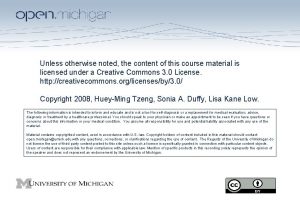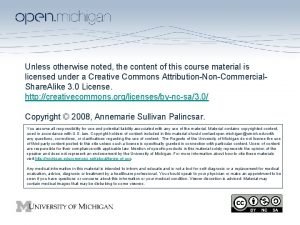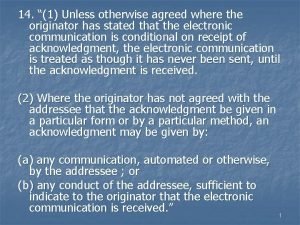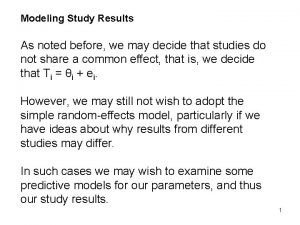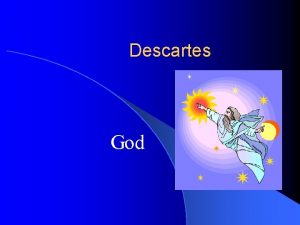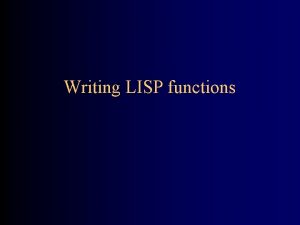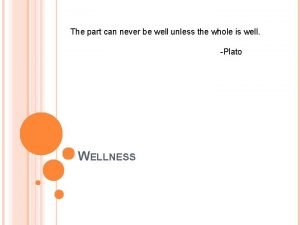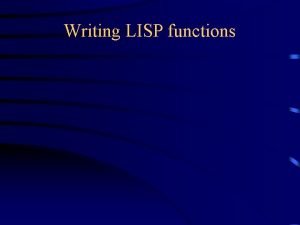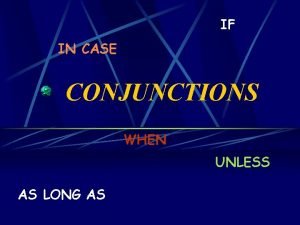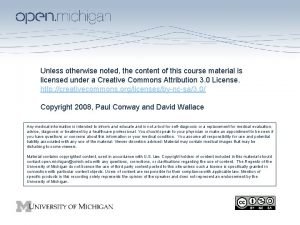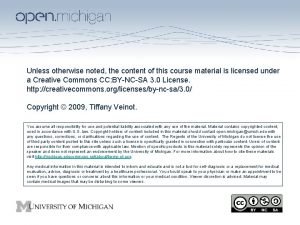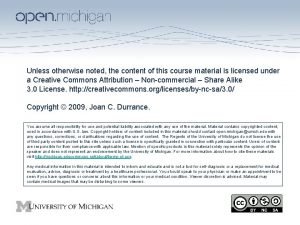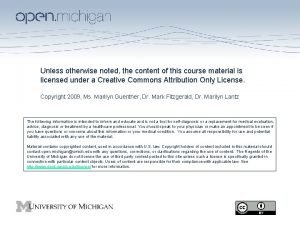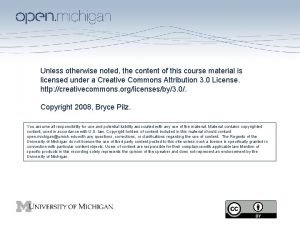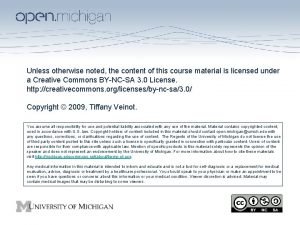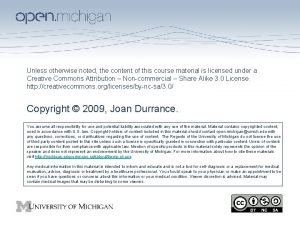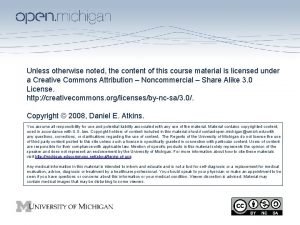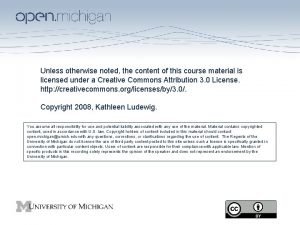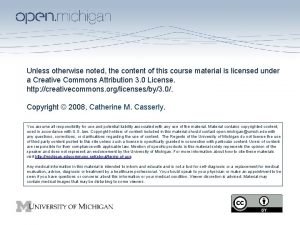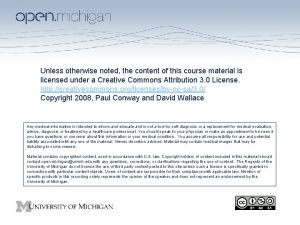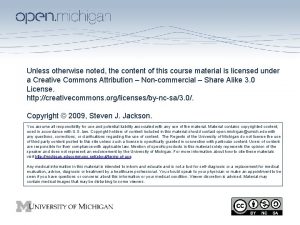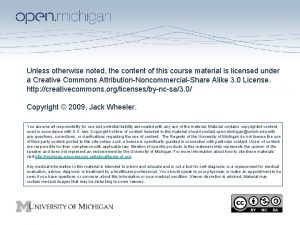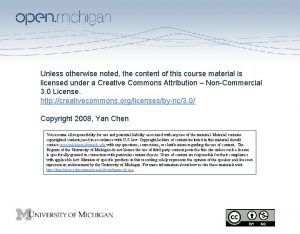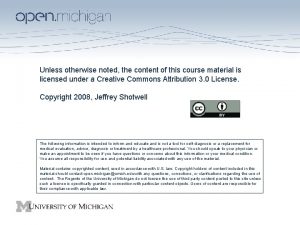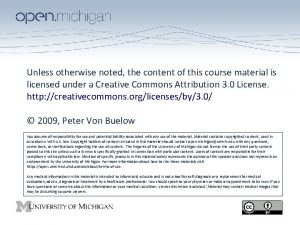Unless otherwise noted the content of this course




















- Slides: 20

Unless otherwise noted, the content of this course material is licensed under a Creative Commons BY 3. 0 License. http: //creativecommons. org/licenses/by/3. 0/ Copyright © 2009, August E. Evrard. You assume all responsibility for use and potential liability associated with any use of the material. Material contains copyrighted content, used in accordance with U. S. law. Copyright holders of content included in this material should contact open. michigan@umich. edu with any questions, corrections, or clarifications regarding the use of content. The Regents of the University of Michigan do not license the use of third party content posted to this site unless such a license is specifically granted in connection with particular content. Users of content are responsible for their compliance with applicable law. Mention of specific products in this material solely represents the opinion of the speaker and does not represent an endorsement by the University of Michigan. For more information about how to cite these materials visit http: //open. umich. edu/education/about/terms-of-use Any medical information in this material is intended to inform and educate and is not a tool for self-diagnosis or a replacement for medical evaluation, advice, diagnosis or treatment by a healthcare professional. You should speak to your physician or make an appointment to be seen if you have questions or concerns about this information or your medical condition. Viewer discretion is advised: Material may contain medical images that may be disturbing to some viewers.

Live from. Physics Ann Arbor, 140 – Fall 2007 lecture #22: 20 Nov it’s Tuesday Morning! Ch 13 topics: • restoring forces produce oscillations • simple harmonic motion (SHM) • damped harmonic motion • natural frequency, driven oscillations and resonance Midterm exam #3 is next Thursday, 29 November covers chapters 9 -12 (rotation through gravity) bring three 3 x 5 notecards, calculator, #2 pencils • Review on Monday, 26 Nov, 8: 00 -9: 30 pm

Which is your favorite FM station? A: 88. 1 B: 88. 3 C: 88. 7 D: 95. 5 E: 97. 9 F: 107. 1

Things that Oscillate CC: BY-NC-SA franz 88 (flickr) http: //creativecommons. org/licenses/by-nc-sa/2. 0/deed. en Source: US Patent CC: BY-SA tacoekkel (flickr) http: //creativecommons. org/licenses/by-sa/2. 0/deed. en e- in antenna pendulum mass on spring

Things that Oscillate: I CC: BY-NC-SA irrelephant (flickr) http: //creativecommons. org/licenses/by-nc-sa/2. 0/deed. en Source: Undetermined Source: US Patent CC: BY murdoch 666 (flickr) http: //creativecommons. org/licenses/by/2. 0/deed. en masses on springs

A restoring force leads to oscillations about a point of equilibrium. http: //en. wikipedia. org/wiki/File: Muelle. gif CC: BY-SA Gonfer (Wikipedia) http: //creativecommons. org/licenses/by-sa/3. 0/

Linear Restoring Forces and Simple Harmonic Motion A linear restoring force tends to push a system back toward a point of stable equilibrium, with a magnitude that varies linearly with the displacement away from equilibrium. An example is Hookes’ law for an ideal spring Applying Newton’s second law gives a second-order ordinary differential equation the solution of which is a sinusoidal variation of position in time Any system with displacement following this form is said to be undergoing simple harmonic motion (SHM).

Conditions for SHM Any system for which the acceleration varies with the negative of the displacement will exhibit SHM. The coefficient between a and x defines the square of the angular frequency w 2. Descriptive features of SHM Although the causes of SHM will vary from one system to another, the sinusoidal variation is a common element. All solutions are directly characterized by three features: xm : maximum displacement amplitude (or amplitude) w : angular frequency f: phase constant (or phase angle) f and w can alternately be specified by either of the following: f : frequency, f = w /2 p measured in Hertz (1 Hz = 1 s-1) T : period, T = 1/f = 2 p/w

The behavior of simple harmonic motion is the same as a linear projection of circular motion. http: //en. wikipedia. org/wiki/File: Si mple_Harmonic_Motion_Orbit. gif

The behavior at t = 0 defines the phase constant f.

A mass attached to a spring oscillates as indicated in the graph below. At the time labeled by point P, the mass has: x(m) t(s) 1) 2) 3) 4) positive velocity and positive acceleration. positive velocity and negative acceleration. negative velocity and positive acceleration. negative velocity and negative acceleration.

Things that Oscillate: II CC: BY-SA tacoekkel (flickr) http: //creativecommons. org/licenses/by-sa/2. 0/deed. en pendulum We use natural oscillations to measure time 1. pendulum 2. quartz crystals Currently, we define “ 1 second” based on oscillations inside a Cesium atom: 1 second = 9, 192, 631, 770 oscillations (303) 499 -7111 : : http: //tf. nist. gov/

A grandfather clock pendulum with period of 1 s in the classroom is placed on an elevator that is accelerating downward at 2. 5 m/s 2. How will the clock’s period in the elevator Televator compare to its period in the classroom Tclassroom? 1) 2) 3) Televator = Tclassroom Televator < Tclassroom Televator > Tclassroom

How long is the rope (g=32. 2 ft/s 2)? A: 7 ft B: 12 ft C: 17 ft D: 22 ft E: 27 ft F: 32 ft

Energy in SHM The linear restoring force has an associated potential energy U that scales as the square of the displacement. The mechanical energy Emec= U(t) + K(t) remains constant if there is no friction (or damping). The kinetic and potential energies in SHM, shown as a function of displacement x, trade roles over the course of a cycle. The peak of one is the valley of the other.

Damped harmonic motion:

Damped oscillations Friction or other sources of external work can lead to a loss of energy, (known as dissipation), from an oscillating system. This phenomenon is referred to as damping. Damping has two principal effects on the oscillating system. It - decreases the amplitude of the oscillations and - decreases the frequency (increases the period) of oscillations. Damping introduces a separate timescale Tdamping into the system. When compared to the oscillation period T, two regimes result Tdamp > T, slow energy loss, or underdamped, Tdamp < T, rapid energy loss, or overdamped.

Natural frequency, driven oscillations, and resonance The oscillation frequency f of a system undergoing simple harmonic motion (e. g. , spring+mass or pendulum) is said to be that system’s natural frequency. If we apply an external, oscillating force that serves to “drive” the system at some driving frequency fd, then the system is able to absorb energy via the work done by the driving force. The condition known as resonance is associated with the state that maximizes the efficiency of energy transfer from the driving force to the system. Resonance occurs when the driving frequency matches the system’s natural frequency fd = f

Amplitude of a driven, damped spring-mass system: driving force leads to oscillation amplitude

Identical cubes of mass m on frictionless horizontal surfaces are attached to two springs, with spring constants k 1 and k 2, in the three cases shown at right. What is the relationship between their periods of oscillation? 1) Ta < Tb < Tc Ta = Tb < Tc 2) 3) Ta > Tb < Tc 4) Ta = Tb = Tc 5) Ta < Tb = Tc
 Unless noted otherwise
Unless noted otherwise Unless otherwise noted meaning
Unless otherwise noted meaning Unless otherwise noted meaning
Unless otherwise noted meaning Unless otherwise agreed
Unless otherwise agreed Nigel barker
Nigel barker As noted before
As noted before Factitious ideas examples
Factitious ideas examples What is esp
What is esp Static content vs dynamic content
Static content vs dynamic content Read and answer
Read and answer Unless
Unless Unless lisp
Unless lisp One sees his finish unless good government retakes the ship
One sees his finish unless good government retakes the ship Romeo and juliet jeopardy
Romeo and juliet jeopardy A unless b
A unless b Unless you repent
Unless you repent The part can never be well unless the whole is well meaning
The part can never be well unless the whole is well meaning Third conditional
Third conditional Literary devices in an elementary school
Literary devices in an elementary school Unless lisp
Unless lisp In case unless
In case unless

